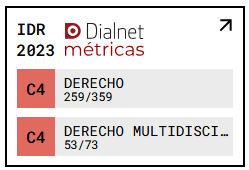Inteligencia Artificial y abogacía
DOI:
https://doi.org/10.18172/redur.5597Palabras clave:
Inteligencia Artificial, Bases de datos, Algoritmos, AbogacíaResumen
El creciente uso de software basado en sistemas de Inteligencia Artificial en la sociedad ha supuesto un cambio de paradigma interpretativo respecto de la finalidad última de este tipo de sistemas, pasando de ser comprendidos como herramientas a, en algunos casos fines en si mismos. El sector legal, y concretamente el ejercicio de la abogacía, no es extraño a estos avances tecnológicos viendo cómo, cada vez con más frecuencia, funciones propias del abogado pasan a estar plenamente automatizadas.
Descargas
Citas
ASIMOV, I., Runaround, Astounding Science-Fiction, Vol. 29, nº 1, 1942, págs. 94-103.
KAPLAN, A., HAENLEIN, M., “Siri, Siri, in my hand: Who’s the fairest in the land? On the interpretations, illustrations, and implications of artificial intelligence”, Business Horizons, Vol. 62, Nº 1, 2019, págs. 15-25. DOI: https://doi.org/10.1016/j.bushor.2018.08.004
FOGEL, D. Review of Computational Intelligence: Imitating Life, Book reviews, diciembre, 1995. DOI: https://doi.org/10.1109/JPROC.1995.481636
MARTÍNEZ GARAY, L., “Peligrosidad, Algoritmos y Due Process: El Caso State v. Loomis”, Revista de Derecho Penal y Criminología, 3ª Época, Nº.20, julio, 2018.
NIEVA FENOLL, J., Inteligencia Artificial y proceso judicial, Marcial Pons, Madrid, 2018.
TURING, A. M., “Computing Machinery and Intelligence”, MIND, Vol. LIX, Issue 236, october, 1950, pags. 433-460. DOI: https://doi.org/10.1093/mind/LIX.236.433
VEGA CARRASCO, M., “La Cliometría, un análisis diferente de la historia.”, publicado en Descubrir la Historia, febrero, 2015. Recuperado de: https://descubrirlahistoria.es/2015/02/la-cliometria-un-analisis-diferente-de-la-historia/
LATORRE, J.I, “La singularidad”, publicado en CCCLAB. Investigación e Innovación en Cultura, 14 de enero de 2019. Recuperado de: https://lab.cccb.org/es/la-singularidad/
Descargas
Publicado
Cómo citar
Número
Sección
Licencia
Derechos de autor 2022 Sergio Capellán Ugalde

Esta obra está bajo una licencia internacional Creative Commons Atribución 4.0.
The works published in REDUR are submitted to the following terms:
- The journal maintains the works published copyright, favours and allows the works reuse under a Creative Commons Attribution-NonComercial-NonDerivs 3.0 Unported license (legal text).
- Permissions beyond the scope of this license may be requested to Copyright Owners.
- Authors accept: the journal’s license of use; copyright policies and self- archiving; open access policy.
- In case of reuse published source must be acknowledged:
- Must include set publisher statement:
First published in Revista del Departamento de Dercho de la Universidad de La Rioja (REDUR) in [volume and number, or year], published by Universidad de La Rioja (Spain). - Set phrase to accompany link to published version:
The original publication is available at: www.unirioja.es/redur







